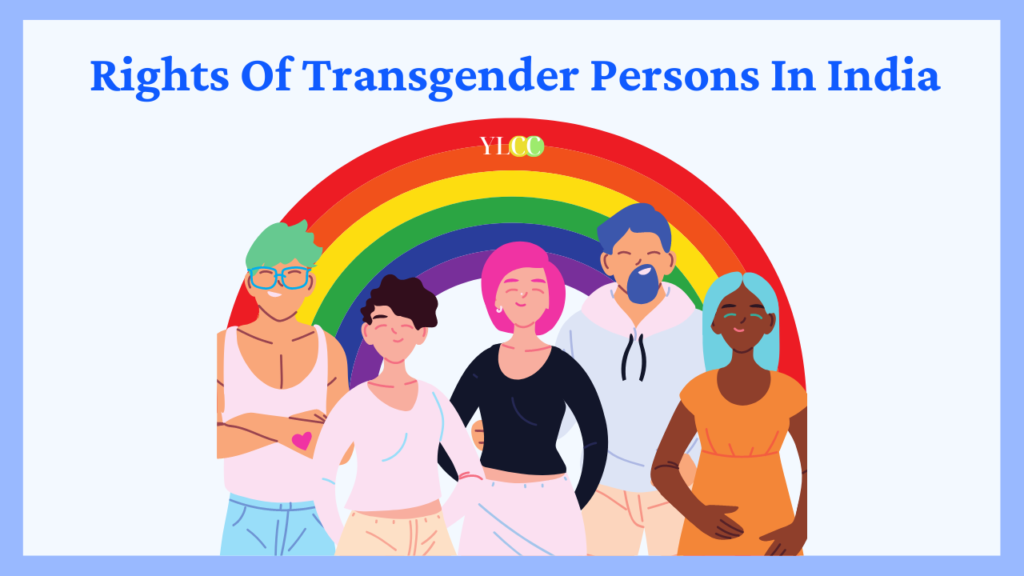
The Bhagwat Gita aims to teach about the soul and how everyone has the right to live their own lives without discrimination. There is no gender for the soul.
INTRODUCTION
Since the beginning of recorded and analysed human life, the third gender, also known as transgender, have existed in each and every culture, race, class, and religion. Individuals of any age or sex who differ from stereotypes in their personality, appearance, attitude, behaviour, or personal characteristics are considered transgender. It means they have different ideas about how men and women should be. They are also a social unit and should have equal rights to everything and every resource available to people all over the world. In India, there are different kinds of transgender communities. The most well-known of such communities are the Kothi, Hijras, Aravanis, Jogappas, and Shiv-shaktis. In this article, Team YLCC brings an overview on the rights and freedoms that are currently enjoyed by the transgender community under the Indian legal framework. Read on!
Transgender people are an important part of the community, but they are often overlooked and denied. It is a biological process that causes changes in the human body. They can be found and seen in every place in India as the most neglected one. When a child is born in a Hindu family, the parents are called to bless the child, and they are also welcomed to bless the newlywed couple. Except in these cases, they are regarded as a social sin and a curse. As a result of society’s refusal to accept their gender identity, they have faced discrimination, social oppression, and physical violence. Many judgements and laws have been passed to safeguard the rights of transgender people.
In the case of National Legal Services Authority v. Union of India (2014)[1], the Supreme Court of India paved the way for transgender rights in India by recognising ‘transgender’ as the ‘third gender’ and establishing several measures to prohibit discrimination against transgender people and protect their rights. The judgement proposed for transgender people to be given preference in jobs and educational institutions, as well as the right of transgender people to assert their self-perceived gender identification without undergoing sex reassignment surgery.
Later in 2019, The Government has enacted the Transgender Person (Protection of Rights) Act[2], which prohibits discrimination in employment, education, and health services for transgender people, as well as welfare measures to protect rights of transgender people.
RIGHTS OF TRANSGENDER PERSON
Following are the rights given to transgender people by the Indian Constitution and the Transgender Person (Protection of Rights) Act:
- RIGHTS UNDER INDIAN CONSTITUTION, 1950[3]:
Article 14 of the Constitution of India, 1950:
Article 14 of Indian Constitution addresses equality under the law or equal treatment under the law within Indian territory. It says that the definition of “person,” includes the male, female, and third gender, implying that transgender people are entitled to constitutional protection under the Indian constitution in all areas of state activity.
Article 15 of Constitution of India, 1950:
Article 15 of Indian Constitution deals with the prohibition of discrimination against any citizen on the grounds of religion, race, caste, and sex, and it includes the third gender as citizens with the right not to be discriminated on the basis of religion, caste, race, or sex. They have the right to protect their gender expression, which is most visible in their clothing, actions, and behaviour.
Article 16 of Constitution of India, 1950:
Article 16 deals with equal opportunity for all citizens in the matter of public employment and Transgender people in India have the right to employment and equal opportunities, and they should not be discriminated against because of their sexual orientation.
Article 21 of Constitution of India, 1950[4]:
Article 21, which outlines the protection of life and personal liberty, states that no one shall be deprived of his life or personal liberty except in accordance to the procedure of law. Transgender people have been denied their right to life and liberty for many years. Now, Transgender Indian citizens have the complete right to protect their rights and personal liberty. By recognising gender identity within the scope of Article 21, the Supreme Court has also recognised the right to dignity.
- RIGHTS UNDER THE TRANSGENDER PERSON (PROTECTION OF RIGHTS) ACT, 2019:
Right to Education:
The education of transgender people is equally important as that of other male or female genders, but the stigmatization that transgender people face breaks their interest and focus on their learning, and they develop a sense of being avoided, ignored, and disgraced, and transgender students are frequently denied admission to educational institutions because the educational establishment does not recognize their gender identities.
The Act of 2019[5] provides that educational institutions funded or recognized by the government must provide education, recreational facilities, and sports for transgender people without discrimination.
Right to Employment:
Transgender people have faced workplace discrimination as well as employment discrimination. They face discrimination in the form of invasion of privacy, refusal to hire, and harassment, that results to poverty and unemployment.
The Act of 2019 states that no government or private entity can discriminate against transgender people in matters of employment, including recruitment and promotions, and every organization should designate a person to be a complaint officer to deal with complaints related to the act.
Right to Healthcare:
Transgender health care services not only refer to the medical procedures involved in transition, but health refers to a complete state of physical, mental, and social well-being. It also refers to a variety of primary and secondary health care services, such as employment, housing, and social acceptability of transgender people. Transgender people have suffered from significant health disparities and barriers to appropriate health care services for many years, causing depression, attempted to commit suicide, harassment and violence, and even HIV.
To protect them and assist them in living a happy life, The Act of 2019[6] lays down that the government should take proper measures to provide health care services to transgender people, including separate HIV surveillance centers and sex reassignment surgeries, and that transgender people should be provided with comprehensive medical insurance.
DOWNSIDES OF THE TRANSGENDER PERSON (PROTECTON OF RIGHTS) ACT, 2019:
The 2019 legislation, although a step forward, was not adequately comprehensive in recognizing transgender rights. Soon after its enactment, the Act was criticized on several grounds which are yet to be implemented.
- Violation of NALSA Judgement 2014:
The NALSA Judgement allowed for gender self-identification and stated that any assertion on Sex Reconstruction Surgery was illegal and immoral. It emphasized that gender self-determination is essential to one’s personality and dignity. The 2019 Act, on the other hand, gives the district magistrate (DM) the authority to recognize a person as transgender and specifies that in order to identify as male or female, one must provide proof of surgery to the magistrate. This gives the DM enormous power, which opens the door to arbitrariness and abuse.
- Minimum punishment for offences against transgender person[7]:
Punishment for sexual abuse of transgender people is inadequate. The minimum sentence for rape under section 375 of the IPC is seven years imprisonment. However, this act institutionalises legal discrimination by making punishment for sexual abuse against transgender imprisonment of not less than six months which may extend only to two years with fine. This also violates Article 14 of the Constitution, despite the fact that the transgender community is particularly vulnerable to such crimes. Thus, there is discrimination in even providing justice to the transgender community, and many of the rights mentioned in the act have no legal remedies, making them rights that are not enforceable.
- Vague and Misleading definition under the Act:
The definition of “transgender person” in the Act is ambiguous and misleading. Section 2(k) of the act defines a transgender person, but it is a limited definition because it only includes four communities: Kinner, Hijra, Aravani, and Jogta. However, it excludes gender non conforming individual and people from other communities such as Nupa Maanba of Manipur and Thirunangais of Tamil Nadu, among others. Therefore, rather than being an umbrella term, transgender has a more restrictive definition. The term also includes people of intersex variation, which is a distinct concept in and of itself. As a result, it appears that the act is conflating sex and gender, reducing the ability to understand the necessities of the transgender community by intertwining the concepts of sex and gender.
CONCLUSION
The concept of human rights is based on the fundamental notion that all humans are equal. It follows that all humans have dignity and should be treated equally. Anything which undermines that dignity is a violation because it violates equality principles and opens the door to discrimination. But the best part is that there are several laws in India to protect their dignity, and transgender people are now coming into sharper focus around the world, with significant advances in many countries in recent years. Today in India, people are learning about homosexuality through books, films, other media and those are helping to normalize their lives.
[1] Abaranji, P. S. A., & Aishwarya, K. (2020). The NALSA Judgement- A legal Standpoint of the Transgender Community with regard to Current Societal Framework. International Journal of Law Management & Humanities, 3(6). https://doi.org/10.1732/IJLMH.25264
[2] Jain, S. (2020, July 2). Pride Month 2020: Evaluating the Transgender Persons Act, 2019. ORF. https://www.orfonline.org/expert-speak/pride-month-2020-68965/
[3] Tope, T. K., Deshmukh, M. V., & Dharmadhikari, S. C. (1986). Constitutional law of India. Lucknow: Eastern Book Co.
[4] Gandhi, D., & Ghia, U. (2019). A Constitutional Challenge to the Transgender Persons Act in India. Blog of the International Journal of Constitutional Law. http://www.iconnectblog.com/2019/12/a-constitutional-challenge-to-the-transgender-persons-act-in-india
[5] Singh Solanki, A. (n.d.). India’s new law on the protection of rights of transgender persons. Back to Diversity and Equality Law Committee.https://www.ibanet.org/article/0F3AE21B-0170-4BF7-95DD-45B07EF1CAF6
[6] Jaddidi Sireesha & Sharma Gunjan. (2021). Position of Transgender in Contemporary India: An Analytical Study. IJLMH .4 (2), 2754 – 2768. http://doi.one/10.1732/IJLMH.26615
[7] Mudraboyina, R., Jagirdar, S., & Philip, P. C. (2019, August 5). A Critique Of Transgender Persons (Protection Of Rights) Bill, 2019. Feminism In India.
YLCC would like to thank Dipti Tharwani for her valuable insights in this article.






